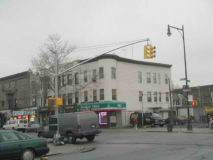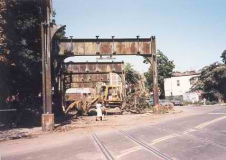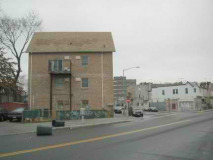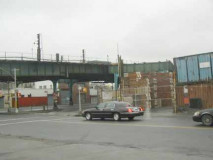The tracks of the Culver Shuttle await disposal at Cortelyou Road during demolition in August 1985
Fewer and fewer subway riders remember the Culver Shuttle, which ran between the 9th Avenue stop on the present W line, and the Ditmas Avenue stop, on the present F. The Shuttle ran between 1954 and 1975 and was itself a remnant of the Culver Line, which was preceded by a steam railroad line, the Prospect Park and Coney Island, which beginning in 1875 ran between 9th Avenue and 20th Street to the present Shell Road and Avenue X.
The line was built by railroad entrepreneur Andrew N. Culver. Beginning in 1889, Culver became a partner in the new Union Depot at 36th Street and 5th Avenue, built to serve Coney Island-bound trains. This was a key turn of events, for it instituted the route the “Culver Line,” as Brooklynites preferred to call it, for the next seven decades.
The PP&CI was soon extended to Coney Island, terminating at about West 5th Street; by 1912, control was passed to the South Brooklyn Railway, and became a Brooklyn Rapid Transit subsidiary. All the while, it was still running on the surface though it had been electrified in 1899.
In 1919, an elevated structure was constructed from about 10th Avenue and 37th Street, removing the Culver trains from street traffic. The new structure bypassed Culver Depot and ran to the brand-new Stillwell Avenue terminal , now being rebuilt. El trains were able to cross the Brooklyn Bridge, run on the Fifth Avenue El and go south to Coney Island over this new Culver El. At the same a connection with the new BRT (later BMT) Fourth Avenue Line was built, enabling West End subway trains to connect with the Culver, which presented no problems since they each ran under the BRT banner.
In 1931, Culver subway trains began to operate to the financial district through the Fourth Avenue Subway, and, for nine years, both subway and el trains plied the Culver Route.”
In 1940 the Fifth Avenue El was suffering from poor ridership due to the Depression and the siphoning off of ridership by the 4th Avenue BMT line a block away. It closed. That same year, the city took over the three competing subway divisions, the BMT, IND and IRT. An IND extension had reached Church Avenue as early as 1933 but since the 1940 consolidation, a connection with the nearby Culver had just been a tantalizing possibility. It was finally attained in late 1954, meaning that subways could run through Cobble Hill, Park Slope and Kensington and then through to Coney Island. But it also meant that the section of the Culver which ran along the private right of way at 37th Street would eventually be doomed. It put up a brave face: some regular routes still ran from Ditmas Avenue (the first stop along McDonald Avenue) and Chambers Street (then the first stop in Manhattan after crossing the Manhattan Bridge) until 1959; from then until 1975, the old line was merely a shuttle, and as we’ll see, it was left to gradually deteriorate and die.
 The massive Culver Depot at Surf Avenue, near the old Luna Park in Coney Island
The massive Culver Depot at Surf Avenue, near the old Luna Park in Coney Island
 From Twelve Historical New York City Street and Transit Maps by John Landers
From Twelve Historical New York City Street and Transit Maps by John Landers
Beginning in the late 1930s, the Hagstrom Map Company began producing what many believe to be the finest NYC subway maps ever made. This 1956 edition shows the Culver between 9th Avenue and its then-new junction with the IND at Ditmas Avenue.
 The Culver Shuttle branched from the West End Line from the lower level of the 9th Avenue station, with trains from the upper level continuing down the New Utrecht Avenue West End elevated line. 9th Avenue remains one of the strangest stations in the system…preserving several anachronisms.
The Culver Shuttle branched from the West End Line from the lower level of the 9th Avenue station, with trains from the upper level continuing down the New Utrecht Avenue West End elevated line. 9th Avenue remains one of the strangest stations in the system…preserving several anachronisms.
 What may be original lamp stanchions from the 9th Avenue platform. The station opened in the summer of 1916.
What may be original lamp stanchions from the 9th Avenue platform. The station opened in the summer of 1916.
The Ninth Avenue shuttle platform in December 1970. The platform would last see active service only five years later, but it has opened periodically for fan trips and movie shoots: the platform stood in for a midtown Manhattan subway platform in 1985 inCrocodile Dundee–ironically, 1985 was the year the elevated structure of the Culver Shuttle was torn down.
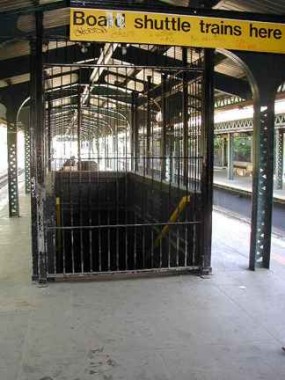 Ironic signage at 9th Avenue today. The sign refers not to the old Culver Shuttle, which closed in 1975, but to the MTA’s practice of breaking up long lines into shuttle runs, in this case, the M train. This staircase did indeed lead down to the Culver Shuttle when it was running.
Ironic signage at 9th Avenue today. The sign refers not to the old Culver Shuttle, which closed in 1975, but to the MTA’s practice of breaking up long lines into shuttle runs, in this case, the M train. This staircase did indeed lead down to the Culver Shuttle when it was running.
 9th Avenue’s lower level is a time capsule, retaining all the black on white column signage as well as the white on blue enamel signage suspended from the roof. Of course the signs have not been cared for and have been left to gather dust and pigeon droppings. In this photo, you can barely make out the numeral ‘9’ on one of the columns.
9th Avenue’s lower level is a time capsule, retaining all the black on white column signage as well as the white on blue enamel signage suspended from the roof. Of course the signs have not been cared for and have been left to gather dust and pigeon droppings. In this photo, you can barely make out the numeral ‘9’ on one of the columns.
 In 1916, a handsome structure was built at 9th Avenue, befitting the station’s former status as a busy transfer point between the West End, Fifth Avenue El, and Culver Lines. You can see the traditional BMT diamonds on the exterior of the brickwork. The interior? A basket case these days. Calling Bob Vila! Nearby, you can catch a glimpse of the very busy MTA 36th Street Yards. Another oddity: adjacent to this station, New Utrecht Avenue begins its diagonal route to Bensonhurst and enjoys its 5 blocks of sunshine before the West End elevated catches up to it. Green-Wood Cemetery‘s sepulchral presence is also near. In the 1970s, a diamond shaped sign hung on the cemetery fence where 9th Avenue intersected 37th Street. It was a DEAD END sign.
In 1916, a handsome structure was built at 9th Avenue, befitting the station’s former status as a busy transfer point between the West End, Fifth Avenue El, and Culver Lines. You can see the traditional BMT diamonds on the exterior of the brickwork. The interior? A basket case these days. Calling Bob Vila! Nearby, you can catch a glimpse of the very busy MTA 36th Street Yards. Another oddity: adjacent to this station, New Utrecht Avenue begins its diagonal route to Bensonhurst and enjoys its 5 blocks of sunshine before the West End elevated catches up to it. Green-Wood Cemetery‘s sepulchral presence is also near. In the 1970s, a diamond shaped sign hung on the cemetery fence where 9th Avenue intersected 37th Street. It was a DEAD END sign.
Note: the station house was renovated, inside and out, in 2012-2013.
 From the lower level of the 9th Avenue station, Culver Shuttle trains exited through this tunnel and ascended a ramp before attaining the elevated structure just before crossing Fort Hamilton Parkway.
From the lower level of the 9th Avenue station, Culver Shuttle trains exited through this tunnel and ascended a ramp before attaining the elevated structure just before crossing Fort Hamilton Parkway.
For much more detailed descriptions and more photos…
Photos by Joe Testagrose and Mark Feinman
New Utrecht Avenue was originally known as the Brooklyn, Greenwood and Bath Plank Road and was built in the early 1850s. The Brooklyn, Bath and Coney Island Railroad was constructed along its path in the 1860s, and finally, the West End Elevated arrived in 1917.
1985
 In 1985, the Shuttle was dismantled from east to west, leaving the Fort Hamilton Parkway stop the last one standing.
In 1985, the Shuttle was dismantled from east to west, leaving the Fort Hamilton Parkway stop the last one standing.
By 1975, New York City was bankrupt, and, whether by design or by their place way down on the list of priorities, the subway system was rotting away. Graffiti-covered trains broke down frequently; doors wouldn’t open or, more dangerously, would fly open on moving trains, and in areas deemed less important by the MTA brass, i.e., lines that didn’t enter Manhattan, maintenance was seriously deferred. A look at the Fort Hamilton Parkway station stop on the Culver Shuttle will tell you it was one of those latter.
In the above photo, you can see that the Culver Shuttle platforms never got concrete sidewalks…the platforms kept their wooden boards till the end.
The stairway from Fort Hamilton Parkway just before demolition.
The remains of the ticket/token booth area, just before demolition in August 1985.
 RIGHT: The Culver was built as a 3-track line but the Shuttle only used one of the tracks. Old BMT Standard cars rumbled the route, and at night, you had bare incandescent bulbs to throw light on your New York Journal American.
RIGHT: The Culver was built as a 3-track line but the Shuttle only used one of the tracks. Old BMT Standard cars rumbled the route, and at night, you had bare incandescent bulbs to throw light on your New York Journal American.
photo: Vincent Losinno
 When I was a kid, my father and I would often go over to 13th Avenue and 37th Street, not to ride the Culver Shuttle (I didn’t become a railfan till a relatively late age, and I’m still not what you’d call a ‘foamer’) but rather to watch the Italian guys play bocce, a game resembling lawn bowling but on a long, narrow court, like a bowling alley.
When I was a kid, my father and I would often go over to 13th Avenue and 37th Street, not to ride the Culver Shuttle (I didn’t become a railfan till a relatively late age, and I’m still not what you’d call a ‘foamer’) but rather to watch the Italian guys play bocce, a game resembling lawn bowling but on a long, narrow court, like a bowling alley.
The Culver lacked what its West End el counterpart sign up the block had… the pretentious faux-Latin sign that said “MVNICIPAL RAILWAY.”
The Shuttle looks about ready to collapse in August 1985. It’s in the final stages of demolition.
13th Avenue and 37th Street, in 1985 and today. One constant in both photographs is Red’s Restaurant, which is on the ground floor of the building right behind the stoplight in the present-day picture.
 South Brooklyn Railway tracks at 14th Avenue and 37th Street. Old New Utrecht Road runs along the building in the background.
South Brooklyn Railway tracks at 14th Avenue and 37th Street. Old New Utrecht Road runs along the building in the background.
The Culver Shuttle passed some real oddities and anachronisms as it made its way to McDonald Avenue. It passed Church Avenue, one of the oldest streets in Brooklyn, beginning its path rather ignominiously at 37th Street on its way to Brownsville; it is named for the Flatbush Reformed Dutch Church, built in 1795, where Church Ave. meets Flatbush Avenue. The Shuttle also rumbled over Old New Utrecht Road, one of Brooklyn’s original farm paths.
And, underneath the Culver Shuttle could be found a freight railroad that survived until about 1980, the South Brooklyn Railway, used mainly to ship subway cars to the (now) MTA’s Coney Island Yards from the waterfront, but it also served some businesses along McDonald Avenue, as well. Originally independent, the “SBK” was acquired by the City in 1940 and became a subdivision of the BMT in 1953. Until the early 1950s, trolley cars also shared the SBK trackage. Freight runs gradually became more and more infrequent, until it was decided to pave over the trackage in the late 1980s. These days any subway car deliveries are done over the elevated Culver Line. Still…at various areas, tracks still poke through the blacktop to remind us of when freights rumbled on the streets of Brooklyn.
 LEFT: From Twelve Historical New York City Street and Transit Maps by John Landers
LEFT: From Twelve Historical New York City Street and Transit Maps by John Landers
Not only is subway service constantly changing, the names of subway lines and the maps that depict them are in constant flux. In 1967, the then-Transit Authority produced this map which is the prototype of the present “Map” (with an extremely stylized interregnum by Massimo Vignelli). In 1967, local lines were still represented by double letters. The TT was the local West End service from Coney Island to 36th Street (with the B an express service; in 2003, the W covers both). The NX was an express N from Brighton Beach to 57th Street, while the RJ ran from Bay Ridge to the now-demolished 168th Street el station in Jamaica. (The RR Chambers Street Special was a remnant of this line that survived till the mid-1980s).
The columns make for a rather Escherian feel.
 Two views from just west of 15th Avenue from 1985 and today. The enormous warehouse is still there between 14th and 15th Avenue. The old Culver Shuttle right of way is used mainly for storage and van parking, although housing has been built west of 12th Avenue and east of 15th Avenue.
Two views from just west of 15th Avenue from 1985 and today. The enormous warehouse is still there between 14th and 15th Avenue. The old Culver Shuttle right of way is used mainly for storage and van parking, although housing has been built west of 12th Avenue and east of 15th Avenue.
The Culver, in its run between 9th and McDonald Avenues, is actually reminiscent of the Chicago els (with the exception of The Loop) in that the Culver ran in its own private right of way. In New York, as a rule, els were built over streets.
photo: Vincent Losinno
Dahill Road plays Sancho Panza to McDonald Avenue’s Don Quixote for a few miles on the boundaries of several Brooklyn neighborhoods, separating Borough Park from Kensington, Mapleton from Midwood. At Dahill, the numbered streets and avenues from Sunset Park and Borough Park meet their demise and lettered avenues, including popular favorites C, F, I and J, begin their march to Flatbush or beyond. In the above 1985 view, the Culver crosses Dahill and the remains of the South Brooklyn Railway are also clearly visible; in the 2003 view, townhouses have replaced the old freights and the rattling of the el.
1985 photo:Vincent Losinno
Finally, the Culver Shuttle met its end at Ditmas Avenue, where a platform allowed a transfer to the Culver Line for passage south to Coney Island or north to Park Slope and Manhattan. As the line crosses Cortelyou Road, some SBK tracks are visible.
 Of course, what became the Culver Shuttle in the 1950s was originally the Culver Line from 9th Avenue to Coney Island. A short ramp and elevated section was built from Church Avenue IND terminal to connect with the Culver at Ditmas. Work on this ramp began in 1941, but World War II held up completion. The two lines were finally linked in 1954
Of course, what became the Culver Shuttle in the 1950s was originally the Culver Line from 9th Avenue to Coney Island. A short ramp and elevated section was built from Church Avenue IND terminal to connect with the Culver at Ditmas. Work on this ramp began in 1941, but World War II held up completion. The two lines were finally linked in 1954
The years between 1975 and 1985 were marked by gradual rot as the structure was allowed to deteriorate. The SBK ceased operations at about 1980, and the bocce players began to find other courts. The area beneath the tracks became a de facto junkyard. When the structure was finally razed in 1985, there was talk of a public park stretching along several blocks, a la Leif Ericson Square in Bay Ridge which runs from 4th Avenue to Fort Hamilton Parkway. But it wasn’t to be: the old ROW became a storage area and truck and school bus parking, with some residential development in the extreme west and east ends. It is what it is.
SUGGESTED READING
How We Got to Coney Island, Brian Cudahy, Fordham University Press, 2002
BUY this book at Amazon.COM
12 Historical NYC Street and Transit Maps, John Landers, 1997 H&M Productions. Officially out of print but can be found at various stores
The Subway, Stan Fischler, 1997 H&M Productions
BUY this book at Amazon.COM
The BMT Culver Line, by Mark Feinman & Peggy Darlington
The Last Day of the Culver Line by Paul Matus
1985 shuttle photos ©2003 Vincent Losinno











